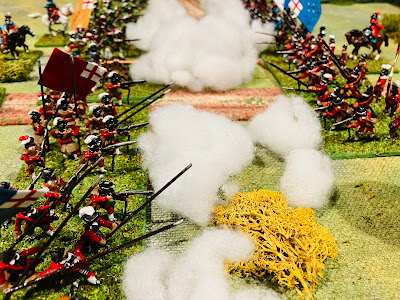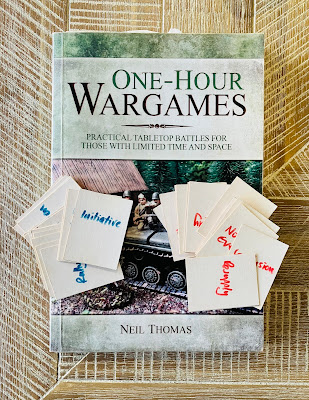Having recently painted another base of English Civil War (ECW) infantry, it was not long before I wanted to get the miniatures onto the tabletop for a game or two. I often use a variant of the One-Hour Wargames Pike and Shot rules and chance cards for my ECW games. As this was a one-off battle I thought I would try and incorporate a pre-battle game that would influence an army's deployment, composition, and also its readiness.
My initial idea was to create a deck of pre-battle cards that players would draw from, but that approach did not seem to be that interesting and lacked any decision making. So I asked ChatGPT for help in coming up with ideas for a set of rules using pre-battle cards. The rule ideas it suggested were very useful and I only needed to make a few adjustments.
The rest of this post covers the first draft of the pre-battle rules and an example of how they were used to create a narrative. The actual battle report will have to follow in a future post, as this post is already getting rather long.
 |
| An ECW game beckons. |
The pre-battle rules take 10-15 minutes to play and are written for a tabletop game using One-Hour Wargames (or variant) which incorporate the use of 15 chance cards. The chance cards are important as this is how the army's readiness is represented.
 |
| OHW rules using chance cards. Each army has 15 cards and a card is draw at the start of each turn. |
Sequence of Play
- Advance Aggressively
- Consolidate Forces
- Secure the Region
 |
| Campaign action cards. Alternatively you can just write down the action. |
Campaign Actions and Their Effect
Advance Aggressively
- +2 CP
- Army composition - Halve the number of artillery units (round down)
- Draw 1 card
Consolidate Forces
- +1 CP
- Army composition - Double the number of dragoon units
- Draw 1 card
Secure the Region
- 0 CP
- Army composition - Halve dragoon units (round down)
- Draw 1 card, if it’s a disadvantage, discard and draw again (keep the second draw)
What to Track Each Turn
- Campaign Points (CP). The player with the most CP at the end will choose the tabletop edge and deploy their army second.
- Event Card Draws. Cards drawn during the campaign influence the Chance Card deck used in the battle.
- Army Composition. Modified based on the last campaign action taken (e.g., fewer artillery, more dragoons).
- Advance Aggressively Tracker. Once two Advance Aggressively actions have occurred in total, the campaign ends.
Ending the Pre-Battle Campaign
- Add up CP totals for each side.
- Resolve card effects (as per the drawn Pre-Battle Event cards).
- Determine army composition based on each player’s last selected action.
Chance Card Deck (for the Tabletop Game)
Initiative (2): One unit may move twice, move & shoot, or shoot twice.Rally (2): 1–3 units remove 1–3 hits (roll 1D3).Confusion (2): Units must roll 3+ on a D6 to move. Any failure and no more units may move this turn.Resupply (2): An infantry, dragoon, or artillery unit that’s out of ammunition is resupplied.Panic (2): The friendly unit with the most hits takes 1D3 additional hits.No Effect (5): Nothing happens.
Pre-Battle Event Card Effects (10 Cards)
Officer Rivalry. Replace 1 No Effect card with a Confusion card.Captured Supplies. Replace 1 No Effect card with a Resupply cardPoorly Trained Recruits. Replace 1 No Effect card with a Panic card.Troops Get Paid. Replace 1 No Effect card with a Rally card.Return of Veterans. Replace 1 Panic card with a No Effect card.Spy in the Enemy Camp. Gain +2 CP.Powder Spoiled. Replace 1 Resupply card with a No Effect card.Rumours of Treachery. Replace 1 Rally card with a No Effect card.Inspiring General. Replace 1 Confusion card with a No Effect card.Clubmen - Pillaged the Wrong Village. Lose 1 CP.
 |
| Some Pre-Battle event cards were quickly made. |
Playing the Pre-Battle Events
- Royalists chose to Secure the Region. They get zero campaign points (CP) and drew "Clubmen - Pillaged the wrong village" which they discarded and drew "Troops get paid" which will add a rally card to the chance card deck.
- Parliament chose to Advance Aggressively gaining 2 CP. They drew "Spy in the enemy camp" which gives them another 2 CP.
- Royalists chose Consolidate Forces. They get 1 CP and drew "Captured Supplies" which will add a resupply card to their chance card deck.
- Parliament chose to Consolidate Forces. They get +1 CP and drew "Inspiring general". This will remove a confusion card from their chance card deck.
- Royalists chose advance Aggressively. They get +2 CP and drew "Powder Spoiled". This will negate the captured supply card removing a resupply card from their chance card deck.
- Parliament chose to advance aggressively. They drew "Poorly trained recruits" that adds a panic card to their chance card deck.
The game's narrative from a Royalist perspective...
Upon learning that the Parliamentarian force was under the command of Sir Nathaniel Cleve, a seasoned officer with experience from the wars on the Continent, Sir Charles resolved to draw in his scattered troops and prepare for battle.
His scouts reported the capture of several barrels of gunpowder from a local storehouse, yet hopes were dashed when it was later discovered the powder had spoiled, likely owing to prolonged exposure to damp weather.
Determined not to linger indecisively, Sir Charles gave the order to march leaving his artillery train to follow up behind. Yet as his force advanced, it became clear that Cleve had either anticipated his movement or had been warned by a treacherous spy. The Parliamentarian army was already in position barring the road ahead.
 |
| A closer view of an ECW game. |
All is now set for a game.
This looks like an interesting system. Thanks very much for posting it! I look forward to reading about the resulting battle.
ReplyDeleteThanks. Parliament seems to be in a good position for the battle.
DeleteWell, AI/ChatGPT seems to have done a decent enough job there. To be fair, I have to say that. Just in case Skynet and/or Terminator try come for me 😉 🤣😂
ReplyDeleteYour narrative ties everything together well and I look forward to reading how you get on with the forthcoming battle,
Cheers,
Geoff
The ChatGPT ideas were most useful for providing a small level of choice into the pre-game activities.
DeleteA very interesting and creative approach to setting the stage for battle.
ReplyDeleteSome of that creativity belongs to ChatGPT.
DeleteAha!
DeleteIntriguing to see you using ChatGPT, Peter, as we were discussing that just the other night during a lull in our Friday night game. Our mate Mark has used it a couple of times for scenario design, too.
ReplyDeleteOne thing I am not sure about in your set up is....what real advantages will the Parliamentarians gain from setting up second when it is a solo action?
The tabletop is randomly generated using terrain cards and more often than not there is a small advantage to choosing a table edge for depolyment.
DeleteSounds like an interesting system Peter and a great way to generate the narrative.
ReplyDeleteSomething a bit different for those one off games.
DeleteA very interesting post Peter. It really set up the game nicely within a narrative context.
ReplyDeleteThank you. I may see if I can develop it a bit further.
DeleteInteresting. I haven't tried chance cards in my gaming at all, though they're favored in Charles Grant's solo-scenario book. I have a set of the VeryBritishCivilWar ones on the way, though.
ReplyDeleteAs mainly a solo player I use chance cards most of the time. Particularly the ones suggested in One-Hour Wargames book.
DeleteSome very neat ideas there Peter. I know the Peter Pig rules have some clever pre-game mechanics, which add a nice mix to the game. In a similar vein the 'Programmed Wargames Scenarios' book allows one to play an opponent as it were, randomly rolling to see what they do, how the deploy etc.
ReplyDeleteI have heard of the Peter Pig rules, but do not have a copy. You remind me to grab Programmed Wargames off the book shelf as there are many ideas within those pages.
DeleteGreat ideas Peter, thanks for sharing these.
ReplyDeleteThanks. They are a work in progress.
Delete